Have you ever been curious about how the universe really looks up close? Then these latest images from the James Webb Space Telescope will be sure to take your breath away. Embark on a tour through distant galaxies, colorful nebulae, and regions where stars are born.
These spectacular views not only bring the stunning beauty and mystery of outer space right to your screen but also show off the power of one of the most advanced telescopes ever made. Get ready to be whisked millions of light years away and discover the wonders of the universe in high definition—each image reminding us of just how vast, dynamic, and endlessly fascinating our universe truly is. So, without further ado , let’s take a look at the cosmos through the eyes of the James Webb Space Telescope.
James Webb Space Telescope (JWST): An Introduction
It is an understatement to say that the science community was abuzz to hear about the launch of JWST on 25th December, 2021. It is the sheer grandeur of the telescope, being the largest one, that made it the talk of the town. The 21 ft diameter ensemble of mirrors, about the size of a football field and a hundred times bigger than that of the Hubble telescope, resulted in this telescope to be one of the finest instruments contributing to astronomy.
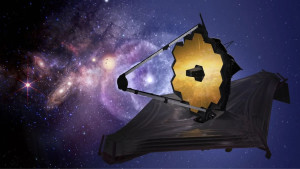
The James Webb Space Telescope mainly observes light in the near and mid-infrared range, allowing detailed exploration of both nearby stars and the most distant galaxies, especially those hidden by dust clouds. The large size of the mirror allows the telescope to gather light from the farthest distances possible, providing the opportunity to explore the universe’s history right from the Big Bang all the way to the exoplanet formation.
The James Webb Space Telescope (JWST) has just begun its cosmic adventure. Designed for a lifespan of 20 years, it’s already making remarkable discoveries, captivating scientists revealing unprecedented detail.. Let’s explore some of its incredible findings here.
Stars Born in the Pillars of Creation
The Eagle Nebula‘s Pillars of Creation amaze astronomers due to its gaseous column-like structures. A famous image taken by the Hubble Space Telescope in 1995 highlights features within these columns. It is worth noting that the Pillars of Creation are not just beautiful structures, but they also provide a glimpse into the busy and exciting ways in which stars are born.

Credits: NASA, ESA
Thanks to observations from the James Webb Space Telescope (JWST), scientists are now able to learn more about the processes involved in the birth of stars using these structures. Having JWST as our eye, now we can see through layers of heavy dust and observe star formation processes in amazing detail.
Observing the Galactic Center’s Dynamics through James Webb Space Telescope
Imagine traveling to the center of our galaxy. Millions of stars gather and swirl around an invisible center like dancers in a cosmic ballet. This is the center of the galaxy, a place where the laws of physics are put to the ultimate test. Stars young and old race around the supermassive black hole at the center of the Milky Way. But what creates this mesmerizing performance? This is where the James Webb Space Telescope steps in.

Credit: NASA, ESA, CSA
With JWST, a huge cloud of gas and dust can be seen swirling around the black hole, forming a vortex of cosmic matter. Some of this matter is destined to be swallowed up by the hungry black hole, further increasing its massive mass. However, other pieces manage to escape and are thrown into space at alarming speeds. The Galactic Center is truly a stage like no other, and the shows that take place there are nothing short of spectacular.
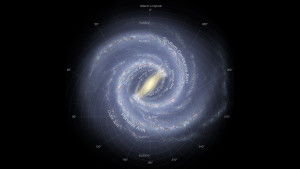
Credits: NASA
If you are interested in Black Holes, you might find this blog on high energy objects really fascinating!
Dust in the universe’s youth
Imagine traveling back in time billions of years and experiencing the universe as it was in its youth. What do you see? Yes, you will be greeted by a swirling cloud of dust that stretches across the galaxy and into eternity. But you may be wondering what all this dust is. Well, it turns out that dust played an important role in the formation of the early universe. At the time, stars were just beginning to form from these cosmic dust clouds. But the story doesn’t end there.
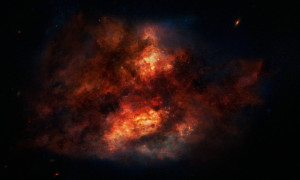
Credit: ESO/M. Kornmesse
This cosmic dust was not only the background for star formation, but also the recycling center of the universe. So, in a sense, dust was the cosmic gardener, tending the fertile fields of the universe and bringing new life and growth wherever it went. And the deeper we probe into the universe with the James Webb Space Telescope, the more the mysteries of this dusty past begin to unravel, and the secrets of our universe’s origins are gradually revealed.
Interested in learning about the formation of stellar systems? You might enjoy reading this!
Unraveling the Mysteries of Exoplanet Atmospheres
Let’s talk about one of the most amazing tasks of the James Webb Space Telescope (JWST). The goal is to study the atmospheres of planets that do not belong to our Solar system. They are called exoplanets. Scientists are very interested in what is happening within their atmospheres. The James Webb Space Telescope is using advanced infrared technology to study the atmospheres of these exoplanets. It’s like putting on special glasses to see what’s happening in the air around these planets.

The JWST closely observes starlight passing through the planet’s atmosphere when exoplanets pass in front of stars. By studying such light, we can predict what types of molecules are present in the atmosphere. Every time JWST studies an exoplanet’s atmosphere, it reveals more about such distant planets.

Witnessing the Birth of Planetary Systems
Let’s take a step further into the cosmic playground where the dust and gas swirl along the vast universe. These tiny dust particles may stick together creating the foundation for a planet. It’s analogous to witnessing a system being created right before your eyes. And the storyteller of our universe, the James Webb Space Telescope (JWST) captures this cosmic drama in great detail for us! With its sharp eyes, we can observe the amazing process of planet formation up close. Every image taken by the James Webb Space Telescope helps us better understand how planets form.

Credit: NASA/JPL-Caltech
Each image shows a new part of history, from rocky planets to large planets made of gas. It’s a cosmic show and thanks to this remarkable telescope, we have front-row seats to the show.
Revealing the Veil Nebula’s Ghostly Beauty
Imagine floating in space until you spot the Veil Nebula, about 2,100 light-years away in the Cygnus constellation. Wouldn’t it be fascinating?!

Credits: NASA, ESA, and the Hubble Heritage Team
It was formed when a giant star exploded, scattering its material into space. Using its infrared vision, the James Webb Space Telescope (JWST) took stunning images of the object.
An illuminated thread of the nebula creates a beautiful play of light and shadow. Some parts shine brightly, while others appear dark because background stars are blocked out. JWST’s images stun scientists, revealing the dramatic story of the star’s explosive end. Studying the Veil Nebula helps us understand the cosmic life cycle.
If you’re intrigued about the death and rebirth of stars, then make sure to check out this blog- Supernova 101!
Capturing the Andromeda Galaxy’s Spiral Arms
The James Webb Space Telescope recently took a spectacular look at one of the most famous neighboring galaxies, the Andromeda Galaxy known as Messier 31, it is the closest spiral galaxy to our Milky Way. Stunning new images released by JWST show the spiral arms of the Andromeda galaxy in stunning detail.
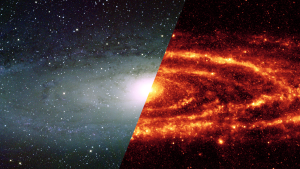
These arms stretch out like cosmic highways, filled with stars and dust, and sparkle beautifully against the cosmic backdrop. Each cluster of light represents a region where new stars are being born. Dark lanes winding through the arms reveal areas filled with cosmic material, perhaps the birthplace of new stars in the future. The release of the images through JWST has sparked excitement and amazement, allowing our celestial neighbor to be seen more clearly than ever before.
Unveiling the Heart of the Crab Nebula

Here’s another amazing object captured by JWST. It looked deep into the center of the Crab Nebula, a famous leftover from a huge star explosion. This nebula is about 6,500 light-years away in the Taurus constellation. In this image taken by the James Webb Space Telescope, we can see, sitting right in the middle, this fast-spinning neutron star called a pulsar which got left behind after the explosion! It sends out rays of energy that make the gas and dust around it glow in pretty colors like blue and green. And there are even these strands of gas spreading out like cosmic strings.
This picture isn’t just pretty; it’s teaching scientists a lot about how these big star explosions affect space around them. Thanks to the James Webb Space Telescope’s special abilities, astronomers can learn more about the secrets of such cosmic events.
Revealing the Antennae Galaxies’ Collision
Imagine two galaxies spiraling through space and slowly coming together in a breathtaking cosmic spectacle. This is the story of the Antennae Galaxies, captured beautifully by the James Webb Space Telescope (JWST). Located about 45 million light-years away in the constellation Corvus, these galaxies are putting on a dramatic show as they collide. Named for their long, stretched “arms” that resemble insect antennae, the galaxies began their slow dance millions of years ago. Thanks to the JWST’s keen eyes, we can witness this incredible dance of destruction and creation in real time, seeing through the cosmic dust.

Credit: NASA, ESA, and the Hubble Heritage Team (STScI/AURA)-ESA/Hubble Collaboration; acknowledgment: B. Whitmore (STScI).
Galaxies are one of the beautiful deep sky objects to observe as a stargazer! If you enjoy stargazing yourself, check out this blog on the top 10 deep sky objects to observe!
Capturing the Essence of the Sombrero Galaxy
In the vast universe, there is a galaxy shaped like a giant cosmic hat. It’s nicknamed the “Sombrero Galaxy” because of its striking resemblance to a stylish Spanish headgear. With the James Webb Space Telescope’s vision, we can see the glory of this hat shaped object. At first glance, you might mistake it for a quiet disk of stars, but look closer and you see something special. A wide brim of dark dust wraps tightly around its domed center.

But what makes the Sombrero Galaxy truly fascinating is what lies within. Deep within its core, billions of stars shine brightly, forming a buzzing center of stellar activity. When we look at the Sombrero Galaxy, we don’t just admire its beauty, every star, every dust cloud contains clues to the galaxy’s past and future. It feels like reading a book about the history of the galaxy.
Detecting water ice plumes erupting from the surface of Saturn’s moon Enceladus
Did you know that a distant moon, Enceladus, orbits Saturn in the depths of space? It may seem like just an icy rock floating in space, but oh! It holds secrets beyond our wildest dreams. Imagine if I told you that this moon is hiding something truly extraordinary beneath its icy shell. Scientists, armed with the powerful James Webb Space Telescope (JWST), recently made a discovery that has set the scientific community abuzz.

Credits: NASA/
They’ve detected water ice plumes erupting from the surface of Enceladus. Yes, you heard that right! Water ice shooting out from the surface of the moon, giving us a peek into what lies beneath. Why is this such a big deal? Well, let us tell you. These plumes are leading us to a hidden treasure—a subsurface ocean. An entire ocean on a moon, millions of miles away! You see, where there’s water, there’s the potential for life. And if Enceladus has an ocean, who knows what wonders might dwell within the depths of the universe?
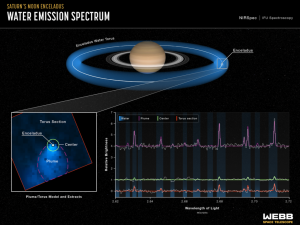
Credits: NASA, ESA
Interested in planetary science? You might like this thought-provoking blog about Saturn’s rings- Can you go-kart on the rings of Saturn?
Unlocking Secrets: Re-imaging the Phantom Galaxy
The Phantom Galaxy can be considered a hidden gem because it’s hard to see – all covered up by dust and gas. But you guessed it! The James Webb Space Telescope is changing the game! This telescope can see through cosmic dust using its infrared vision. So now, scientists are getting a super clear view of the Phantom Galaxy, seeing things they’ve never seen before, like its spiral arms and where new stars are born. By studying this sneaky galaxy, scientists are learning tons about how galaxies form and grow. It’s like uncovering secrets about the whole universe! Comparing it to other galaxies helps to figure out how everything fits together in the cosmic puzzle.

Fascinated by these amazing discoveries? Hold tight, because our hero, the James Webb Space Telescope, is just warming up. Countless amazing stories are waiting to unfold. Stay tuned.
Looking for a stargazing opportunity? Join us for a night under the stars at our upcoming events. Want to see what’s coming up? Click here to find out.
Stay updated on the latest astronomical events and discussions by joining our Discord channel! Ask any astronomy-related questions we’re here to help you explore the wonders of the cosmos.
ENJOYED READING THIS? CONSIDER READING
- Stellar Evolution: 4 Incredible Stages from Formation to Final Collapse
- Dark Matter: 10 Unaswered Questions That Will Leave You Intrigued
- Top 5 High Energy Objects in the Universe
- The 101 to the amazing James Webb Space Telescope



